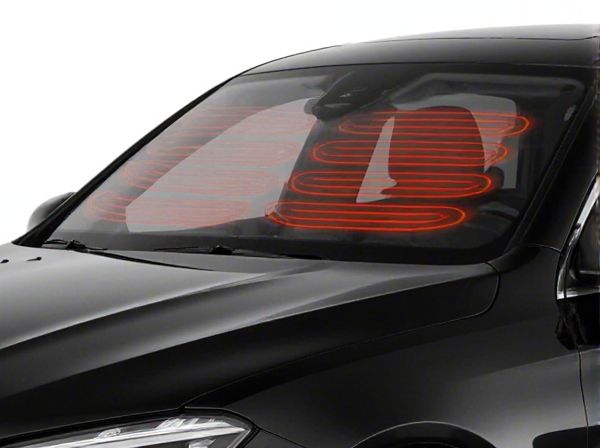
Photo illustration: Heated Windshield vs Non-Heated Windshield
A heated windshield offers faster defrosting and improved visibility during cold weather by using embedded heating elements, which enhances safety and convenience. Non-heated windshields rely on external temperature and manual scraping, making them less efficient in ice and frost removal. Choosing a heated windshield can significantly reduce preparation time and provide a clearer view in adverse conditions for your daily driving.
Table of Comparison
| Feature | Heated Windshield | Non-Heated Windshield |
|---|---|---|
| Defrosting Speed | Rapid defrosting and de-icing | Slower, manual defrost required |
| Visibility | Clearer in cold, frosty conditions | Prone to fog and ice buildup |
| Safety | Improved driver safety due to better visibility | Higher risk in winter driving |
| Energy Consumption | Uses vehicle electrical system power | No additional power needed |
| Cost | Higher initial and maintenance cost | Lower upfront cost |
| Durability | Designed to withstand heat cycles | Standard windshield material |
Introduction to Heated vs Non-Heated Windshields
Heated windshields incorporate embedded heating elements that rapidly melt ice, snow, and fog, improving visibility and safety during cold weather conditions. Non-heated windshields rely solely on external defrosters or manual scraping, which may delay clear vision and increase risk in freezing temperatures. The integration of heating technology directly within the glass surface offers enhanced convenience and efficiency compared to traditional non-heated options.
How Heated Windshields Work
Heated windshields use embedded thin, transparent heating elements or conductive coatings that generate warmth when electrical current passes through, effectively melting ice and snow. This technology enhances visibility and safety by quickly clearing frost without the need for external scrapers or prolonged engine idling. In contrast, non-heated windshields rely solely on defrosters and manual scraping, which can be less efficient in harsh winter conditions.
Benefits of Heated Windshields
Heated windshields offer enhanced visibility by quickly melting ice, snow, and frost, reducing the need for manual scraping and improving driving safety in cold climates. They prevent condensation buildup, maintaining a clear windshield and minimizing glare, which is crucial for night driving. Energy-efficient heating elements integrated within the glass ensure rapid defogging without significant power consumption compared to auxiliary defrosting devices.
Drawbacks of Heated Windshields
Heated windshields, while effective in rapidly melting ice and fog, often come with higher installation and repair costs due to embedded heating elements. The electrical components may degrade over time, potentially leading to uneven heating and reduced visibility. Non-heated windshields avoid these issues but require manual defrosting and longer wait times in cold conditions.
Advantages of Non-Heated Windshields
Non-heated windshields offer cost efficiency by eliminating the need for embedded heating elements, reducing initial purchase and repair expenses. These windshields maintain structural integrity without the risk of damage from heating components, enhancing durability over time. Their simplicity results in fewer electronic failures, providing reliable performance in a broad range of environmental conditions.
Disadvantages of Non-Heated Windshields
Non-heated windshields often accumulate frost, ice, and snow, significantly reducing visibility and increasing the time needed to clear the glass before driving. Lack of built-in defrosting capability can lead to frequent manual scraping, which risks damaging the windshield surface. These disadvantages contribute to decreased safety and convenience during cold weather conditions.
Cost Comparison: Heated vs Non-Heated Windshields
Heated windshields typically cost between $500 and $1,500, including installation, compared to non-heated windshields which range from $200 to $400. The added expense of heated windshields is due to embedded heating elements that prevent ice buildup and improve visibility in cold climates. Over time, the energy efficiency and safety benefits of heated windshields can offset the initial higher cost for drivers in regions with frequent freezing conditions.
Installation and Maintenance Requirements
Heated windshields require specialized installation involving embedded heating elements and electrical connections, which make the process more complex and costly compared to non-heated windshields that fit standard glass mounts without extra wiring. Maintenance for heated windshields includes regular inspections of the heating elements and electrical system to ensure optimal functionality, while non-heated windshields generally only need routine cleaning and chip repairs. Repairing or replacing a heated windshield often demands professional service to avoid damaging the heating components, whereas non-heated windshields can be replaced with standard glass replacement techniques.
Which Windshield is Right for Your Climate?
Heated windshields provide enhanced visibility and safety in cold climates by quickly melting ice and preventing fog buildup, making them ideal for regions with frequent snow and freezing temperatures. Non-heated windshields are suitable for milder climates where frost and ice are less common, offering standard protection without the added cost or energy consumption. Choosing the right windshield depends on analyzing local weather patterns and prioritizing convenience and safety during winter driving conditions.
Conclusion: Choosing the Best Windshield for Your Vehicle
Heated windshields offer enhanced visibility and faster defrosting, making them ideal for cold climates and improving driving safety. Non-heated windshields are generally more affordable and suitable for moderate weather conditions, providing reliable protection without additional energy consumption. Selecting the best windshield depends on climate, budget, and personal preference for convenience and safety features.
 caratoz.com
caratoz.com